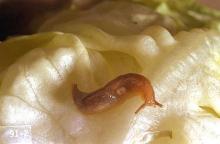Includes
Gray field slug (Deroceras reticulatum)
Greenhouse slug (Milax gagates)
Marsh slug (Deroceras laeve)
Red slug (Arion spp.)
Reticulated slug (Prophysaon andersoni)
Spotted garden slug (Limax maximus)
Pest description and crop damage Slugs are active above ground primarily at night, and also during mild, wet periods any time of year. Very little activity takes place in cold, freezing, or extremely hot weather. During the day, slugs usually stay in the soil or in crevices or cracks in order to protect themselves from dehydration and predators. Slug damage can be distinguished easily by the presence of slime trails. Slug damage tends to be heaviest along field margins. Weedy or grassy borders serve as excellent habitat for slugs.
Management-chemical control
Fall baiting is usually recommended for non-irrigated crops. Apply bait after the first rain showers, when slugs become surface active. Bait applied immediately after the first fall rains kills a large population in the field.
- metaldehyde baits (Slugger 4.0 and others) at 5 to 20 lb/A (0.2 to 0.8 lb ai/A). REI 12 hr. Retreatment interval 14 to 21 days. Do not exceed four applications per season. NOTE: this product may only be used in Oregon for lettuce seed production under a Special Local Need label (SLN OR-140004 and others).
- sulfur baits (Bio-Sul) at 20 to 44 lb/A (0.20 to 0.44 lb ai/A). REI 24 hr. Use higher rate for heavy infestations.
See also:

